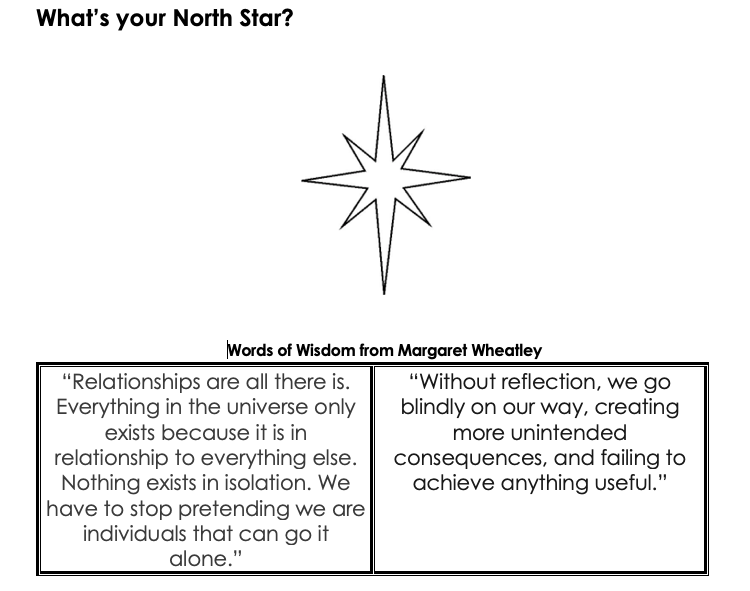Our North Star: Building Relationships & Collaboration Through Asset-Based Protocols
Barry and I have been colleagues for the last 6 years. We first met while supporting a school in Harlem and then continued our work across the miles — coast to coast — through Sunday morning co-planning calls and writing. We are a great pair because we’ve nudged one another to think deeply about the things that matter to our practices and we hold inquiry and assets at our center. One of the best parts about our work together is the bridge we’ve created between our professional and personal lives. It’s pretty typical for Barry and I to launch or end our planning calls with, “what’s happening with the family?” type of dialogue. We work hard at keeping it real — real people, real lives, real work. We wouldn’t have it any other way. It doesn’t hurt, either, that we really dig each other’s spouses and kids—what blessings they are to each of us!
So, why all this chatter about our connection? For us, relationships, collaboration, and working with an asset-based mindset matters. We’ve worked to put our beliefs about learning, both with adults and students alike, into practice. Specifically, we believe learning is maximized when:
we build lasting RELATIONSHIPS with our colleagues
we work toward COLLECTIVE GOALS with SHARED AGREEMENTS about how to get where we are going
we catch the good — going after ASSET-BASED PROTOCOLS — always
we approach all problems of practice through MULTIPLE ENTRY POINTS
we create learning environments where everyone has something to GIVE and everyone has something they can GET
we use REFLECTION to look back in order to create steps forward
About once or twice a year, Barry and I try to live out our beliefs by working and learning alongside one another in the same space. Whether that’s Barry making his way east to take a class in NYC or my heading west to learn in his classroom, thinking and planning together has been a cornerstone of our work.
A few weeks ago, we had the pleasure of co-hosting a Learning Lab in Barry’s classroom. The classroom organization and culture, his students, and students’ work became our text for learning. Because collaboration is central to our work, we invited some colleagues to join us. It’s hard to really capture all of the beauty that came about — individually and collectively —from participants. What follows is a snapshot from our Bainbridge Island Learning Lab experience.
Reflection: Our educational North Stars are the things that help us hold steady while other things [priorities, initiatives] continue to move and change. Defining and living within your professional North Star helps you stay grounded in your work, regardless of what comes your way.
Reflection: Using asset-based protocols — catching the good — when observing a classroom builds relationships, fosters trust and safely for everyone involved.
A big thank you to my friend and mentor, Sam Bennett, for sharing this protocol with me 10 years ago. It worked then and it still works today!
Teachers kidwatching — using a note catcher to collect asset-based evidence.
Reflection: Being clear with how time will be used across a workshop — both for yourself as the facilitator of learning and for the kiddos — is directly linked to student independence.
Posted in Barry’s classroom and revisited at the beginning of workshop.
Reflection: Creating efficient, effective and sustainable systems and structures for noting student observations —as you study and interact with students in whole group, small group, and 1:1 — is a key ingredient for future, instructional decision-making.
Graph paper + student headshots + clipboard + pen!
Reflection: If we believe in EYES ON PRINT, EYES ON PRINT, EYES ON PRINT, then choice in text type + seating makes a BIG difference for kiddos buying in and settling in for independent reading time.
Who wouldn’t want to dive into a text when you can sit around the “family room” to read!
Reflection: Biographies come in lots of shapes, sizes, and lengths. Sometimes reading lots of short texts builds reading volume in ways that one long chapter book biography can’t. Giving kiddos the choice is important.
Reflection: When students hold their thinking, it gives them opportunities to make meaning of the texts they are reading.
Reflection: Conferring with students provides insights and is one of the most meaningful, on-the-spot forms of formative assessment.
Reflection: One of the most powerful parts of a Learning Lab is the reflection that follows — cracking open the thinking behind the planning & instructional moves. It’s that metacognition that helps others imagine the implications for their work going forward.
Reflection: Sometimes we write to make sense and/or solidify our thinking or reflections. If you’d like to read some of Barry’s reflections after this Learning Lab, check this out!











